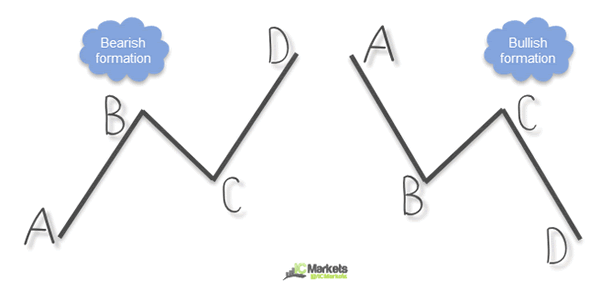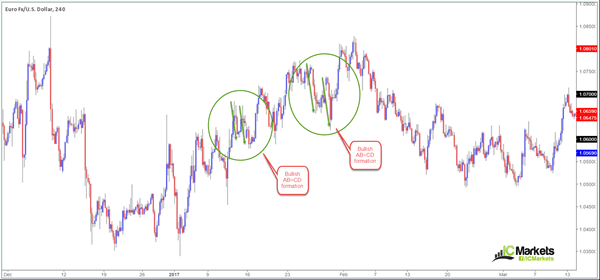Developed by Scott Carney and Larry Pesavento, after being originally discovered by H. M. Gartley, the AB=CD pattern has become an effective technique to have in one’s toolbox. After months of research, back testing and also live trading, we feel comfortable presenting this setup to our readers. Just to be clear, the following is not the holy grail. We’ve simply took what Carney and Pesavento taught and traded it in our own way, and so far, it’s worked nicely.
To avoid over complicating things, let’s take it from the top…

Our way of identifying this formation starts with labelling the four legs: A, B, C, D. The AB=CD pattern means that the CD leg should be at least equal to the length of the AB leg. As can be seen from the diagram above, this is the framework. A rising AB=CD pattern is considered bearish, whereas a descending AB=CD pattern is bullish.
Some traders choose to count how many candles it takes to form the AB leg and then look for a corresponding quantity to be created on the CD leg. Not that there’s anything wrong with this, we just choose not to follow this approach.
Below are two bullish AB=CD configurations on the EUR/USD H4 chart that worked out beautifully:

Mr. Fibonacci!
We know of some traders who simply trade the above formation and do very nicely. They are not concerned with Fibonacci drawings. Nevertheless, we find these calculations helpful…
In essence, we look for the BC leg to record a 61.8% Fibonacci retracement. To do this, draw the Fib tool from the A point up to where B completes. Price cannot register a close beyond the 61.8% level – ideally price is to respect this level, give or take a few pips. Carney, on the other hand, states that ‘the C point must retrace to either a 0.618 or 0.786’.
The reversal zone (the D-leg completion), is where we look for either a 127.2% or 161.8% Fibonacci extension to converge. Carney called this the ‘alternate AB=CD’ pattern.
Quite a mouthful, we know! Hopefully the diagram below will help clarify this…

Here’s a live chart showing both a bullish and bearish setup with the Fibonacci drawings attached:
Long setup:
As can be seen from the chart, the pattern held firm at the top edge of the 161.8/127.2% reversal zone and rallied a respectable distance!

Short setup:
This sell trade, while the area was respected, was unable to surpass minor structure formed from the high circled in green.
Why we choose to adopt the noted Fibonacci calculations is simple. As the two live examples show, using both the 127.2/161.8% Fibonacci extensions help define a reversal zone (see the green areas). The reason for strictly adopting the 61.8% Fibonacci retracement value at the BC-leg completion is due to this giving better results in our back test, nothing more than this. We found that if price drove too far beyond the 61.8% value, the setup was not as successful.

Further considerations:
- We have found the pattern works far better when the (D) completion point fuses with some kind of structure to the left. What we mean by structure is supply and demand, support and resistance, psychological levels etc.
- In our view, trading the AB=CD as a trend continuation pattern is the better route to take. Although they also work countertrend, trading with the trend tends to be more reliable.
- What timeframe is best? The pattern can be seen on the M1 right up to the monthly timeframe. It is said that the higher timeframes are more consistent, but we’ve had success using this pattern on the M15, M30 and H1 charts. We’ve yet to test the validity of the M1 and M5 so it’s difficult to judge.
In closing…
Take your time learning this setup. A lot of professional traders use this pattern either as a setup in and of itself or as a way of further confirming another setup.













